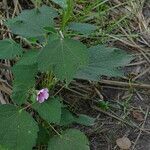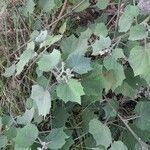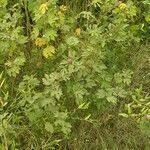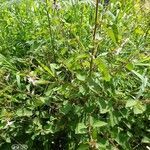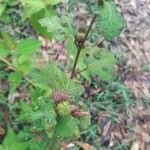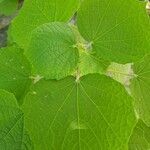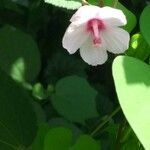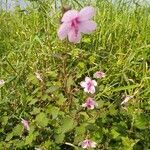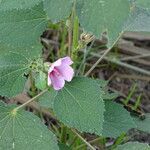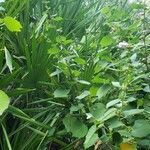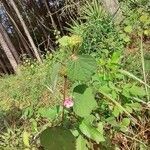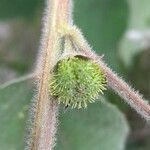Subshrublike herbs, erect, to 1 m tall. Branchlets stellate tomentose. Stipules filiform, ca. 2 mm, caducous; petiole 1-4 cm, gray-white stellate; leaf blades on proximal part of stem nearly orbicular, 4-5 × 5-6 cm, base rounded or nearly cordate, margin serrate, apex 3-lobed, blades on middle part of stem ovate, 5-7 × 3-6.5 cm, those on distal part of stem oblong to lanceolate, 4-7 × 1.5-3 cm, abaxially gray stellate puberulent, adaxially puberulent. Flowers solitary or slightly aggregated, axillary. Pedicel ca. 3 mm, woolly. Epicalyx lobes connate for ca. 1/3 length, ca. 6 mm, puberulent. Calyx cup-shaped, lobes 5, slightly shorter than bracteoles, stellate puberulent, caducous. Corolla reddish, ca. 15 mm in diam.; petals 5, obovate, ca. 1.5 cm, abaxially stellate puberulent. Staminal column ca. 15 mm, glabrous. Style branches 10, hirsute. Fruit flattened globose, ca. 1 cm in diam.; mericarps stellate puberulent and spiny with hooked spines. Fl. Jul-Oct.
An evergreen shrub or herb. It grows from seed each year. It grows to 2 m high and spreads to 2 m across. The stem is erect, coarse and hairy. It has an open crown. The bark is stringy. Leaves are green and have 3-5 lobes. They are soft, hairy on both sides and 4-8 cm long by 2-8 cm wide. Underneath the leaf is white with prominent veins. The edges of the leaves are finely toothed. Leaves occur at the tops of branches. The leaf stalks are hairy. Flowers occur singly and have petals united forming a tube. Flowers are pink or can be violet with yellow in the middle. The petals are soft. Flowers are 1-4 cm across. The fruit is a rough, spiny, woody, capsule. It is about 1 cm across. It has 5 cells each with one seed. The seed are wedge shaped and 3 mm long. They have a dull surface and are dark brown. There are named varieties.
Plants 1 m. Stems minutely stellate-hairy. Leaves reduced distally; stipules 2–4 mm; petioles equaling blades proximally, reduced distally to 1/4 blade length; blade paler abaxially (slightly discolorous), broadly to narrowly ovate, angulate to shallowly lobate with ± acute sinuses, usually 3–9 cm, apex acute. Inflorescences subsessile or pedicels to 7 mm; involucel 5–6 mm, subequal to calyx, lobes alternate with calyx lobes. Flowers: calyx 1/2-divided, 5–9 mm, hairy, lobes ciliate; petals 15–20 mm, abaxially hairy; staminal column 5-dentate apically, glabrous; filaments nearly absent; anthers subsessile, usually pinkish; style reflexed, slender; stigmas 2 times number of locules. Schizocarps 5-lobed, 8 mm diam., lobes convex, stellate-hairy, glochidiate-spiny spines numerous. Seeds 3–5 mm. 2n = 28, 56.
Leaves 3–5-palmatilobed with entire to pinnatisect lobes; lamina of lower leaves 4–6 × 5–7 cm., usually suborbicular, shallowly 3-lobed at the apex, rounded to subcordate at the base, of middle leaves 5–7 × 3–6·5 cm., often more ovate, of upper leaves ovate-elliptic; margin evenly or irregularly serrate; petiole 2–4 cm. long; stipules c. 3 mm. long, lanate.
Suffrutex up to c. 1 m. tall; stems sparsely to densely stellate-tomentose.
Calyx shorter than the epicalyx, densely lanate at the base of the keels.
Epicalyx c. 6 mm. long, connate in the lower 1/3 stellate-pilose.
Varying from a low woody weed to a shrub 8–10 ft. high
Flowers solitary; pedicels c. 3 mm. long, lanate.
Flowers rose-pink or yellow, 1 in. or less long
Cultivated in some of its forms.
Petals 10–15 (25) mm. long.
Fruit c. 10 mm. in diam.
